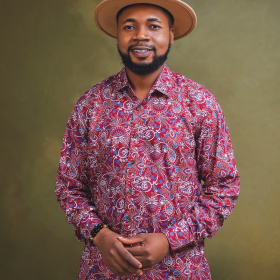The recording industry in Tanzania
By John Kitime
The recording industry in Tanzania began with the introduction of the first radio station, Sauti ya Dar es Salaam (Voice of Dar es Salaam), in 1951. At first, the radio was only able to broadcast in and around Dar es Salaam, then the capital city, but by 1955 the coverage was practically nationwide.
 Talent recording session Photo: kefapro.blogspot.com
Talent recording session Photo: kefapro.blogspot.com
The station was renamed Tanganyika Broadcasting Services (TBS) and in 1956 again to the Tanganyika Broadcasting Corporation (TBC) and began recording various types of music strictly for broadcast purposes[i]. After independence in 1961, there was heightened demand for the ‘Africanization’ of radio content, instead of it simply being a relay station for the BBC.
The need for local programming increased the need to record as much local music as possible. For many years that followed, musicians in Tanzania could only record in the studio owned by the state-operated radio station, still the only station in the country, which in 1965 was renamed again to Radio Tanzania Dar es Salaam (RTD).
The music recorded was used in programmes aired by the radio station. However, a censorship committee was formed and all local popular music had to be approved by this board before it could be recorded. Many songs were therefore never recorded or had two different sets of lyrics - one for the radio and the other for live shows. Some more ambitious musicians crossed the border to Kenya to record, such as the Afro 70 Band, Morogoro Jazz Band and the Cuban Marimba Band.
Some bands had to change their names, for example the band ‘owned’ by the ruling CCM party, which was known as Vijana Jazz band, who recorded in Kenya as the Kokakoka Sex Battalion. As a result, many songs at the time had two versions - the Tanzanian radio version and the Kenyan recorded version. For example, all the recordings that Safari Trippers did in Kenya are different from the radio versions. The radio recordings were typically of better quality.
Early recording studios
In the mid-1970s, political relations between Kenya and Tanzania grew sour. The ambitious East African Community broke up and for a time the Kenya-Tanzania border was closed. Musicians who once travelled freely between these borders to record could no longer travel to Kenya legally. The Tanzania Film Company (TFC), which had been established in 1968, began recording and releasing records in the 1970s, making it arguably the first authentic record label in Tanzania.
The label released artist such as The Sunburst, Lucky Star Taarab Group, and the Tanzania All Stars. The TFC was a government-owned company that also released a number of films, mostly documentaries. However, TFC did not own a vinyl pressing plant and so some of its releases were pressed in Zambia. In the early 1980s there was a plan to build a pressing plant in the Mikocheni area of Dar es Salaam, but the project never materialized and the buildings have since been turned into the Tanzania School of Journalism and Mass Media[ii].
One of the earliest private studios to emerge in Tanzania was Habari Maalum, a recording studio established in Arusha, near the Kenyan border, in 1974. This studio catered only for gospel music and released hits from the Arusha-based choir Arusha Town Choir, which produced the evergreen hit ‘Kila mtu atauchukua mzigo wake mwenyewe’. The studio is still in existence and presently also produces radio and TV programmes[iii].
The technology of mass-producing audio cassettes created a new opportunity that Tanzania musicians had lacked until then: an ability to distribute their music. RTD Studios could no longer cope with the demand for recording. This, coupled with the censorship issue, highlighted the need for alternative recordings studios. In time, as the political situation changed and the country moved away from socialism to a free market economy, censorship became less of an issue for musicians, and numerous new studios began to emerge.
Modern recording studios
One of the first private studios in Tanzania was a simple studio established in 1992, owned by the Muhuto Brothers, who came from a family with a long tradition of musicians. The studio began recording bands such as the African Warriors and Vijana Jazz Band (on their album Kapu la Mjanja) on their two-track reel-to-reel tape recorder in a bedroom roughly converted into a studio, with blankets hanging here and there to better the acoustics. Today the studio seems to be erratically opening and closing.
A huge leap forward came with the establishment of three eight-track studios by the Roman Catholic Salesian Society of Don Bosco in the 1990s. These were situated in Sumbawanga, a small town in the south of the country, Iringa in the southern highlands and in Dar es Salaam’s Upanga area. The latter became one of the most important studios in the mid-1990s. Using the Tascam 488 Mk II Portastudio 8-Track Analog Tape Cassette Recorder, the studio recorded hundreds of musicians, such as Magoma Moto Sound, Maquis du Zaire, Tabora Jazz band, Police Jazz Band and many others. The studios closed down in 2001 mostly because the equipment became obsolete with the coming of digital recordings. The engineers simply moved to other studios, with Marlon Linje moving to MJ Studios and Richard Mloka to Marimba Studios.
Another influential studio was Mawingu Studios, which was established in 2000 and was based in Dar es Salaam. It began recording the new generation of Tanzanian artists, who had begun shaping their music with more western influences. The popular Bongo Flava genre owes its roots to this studio. Instead of being written by a band in a rehearsal room, most of the music was created in studio. The studio owners, Clouds Media, have gone on to run a very popular radio and TV company[iv].
Another important recording studio formed in the 1990s was that of the Big November Crusade Ministries, which was based in Dar es Salaam. The studio was very spacious as it was built to be able to accommodate choirs of up to 30 singers. Next to RTD Studios this was the most spacious studio. Unfortunately the studio shut down in 2000.
In 1998, the Tanzania Musicians Association (CHAMUDATA), which does not seem to be active any more, signed an MOU with the Norwegian Stromme Foundation[v]. As a result, Tanzanian musicians were provided with the first fully digital recording studio in the country, named Marimba Studio. It was based in Ilala District in Dar es Salaam. The studio had a Yamaha O2R mixer and two Tascam D88 recorders. Many artists from all over the country - bands such as The Kilimanjaro Band and Super Sikinde, choirs such as the Nzega Choir and solo artists such as Dully Sykes - recorded here between 1999 and 2004.
Importantly, the studio was used as a training school for sound engineers, with no less than 10 sound engineers being trained directly by the studio. For example, John Sagati and Yusuph Mirambo were trained here by the chief engineer Keppy Kiombile. In 2003 the studio was handed over to the Kilimanjaro Band, which continued to record there and to train sound engineers under a new name, Njenje Productions. In 2009 the studio finally closed down, allegedly due to wear and tear of its equipment.
Around the year 2000, another high-tech studio was built. It was known as Concord Studios and was established in a relatively posh part of Dar es Salaam known as Masaki. Unfortunately the studio never recorded any albums, apart from the band that the studio owner owned, and these songs were never released because of copyright complications that arose between the owner and the band. The owner later quietly dismantled the studio and has never been heard from since then.
FM Studios, also based in Dar es Salaam, was a notch higher than most other recording studios with more sophisticated technology, as well as a Danish studio engineer Mikka Mwamba. The studio churned out many songs, and it’s through this studio that the world came to know of Saida Karoli, the famous traditional singer. The owner, Felician Mutta, was also a big music distributor, who even came up with radio programmes to advertise his new releases. The studio thus functioned much like a record label. The studio closed around 2009.
While there are hundreds of small recording studios scattered around the country, the biggest and the most famous are based in Dar es Salaam.
Record labels
Other Tanzanian studios are also part of independent labels. The studio of Sound Crafters Records is based in Temeke District in Dar es Salaam. It is one of the oldest existing studios and was established by musician brothers Roy and Enrico Figueiredo in the early 1990s. Since then it has been recording almost all types of Tanzanian music. It’s a home to many musicians, both old and young generations, and has close ties with the InAfrika Band, which was started by the same brothers.
Bongo Records, based in Mwenge, Dar es Salaam, is credited with starting the Bongo Flava movement. This was the studio that began churning out the famous Bongo Flava artists. It is even claimed that the name Bongo Flava began in this studio. The studio CEO is P Funk Majani, a popular local hip-hop artist.
Despite have numerous recording studios, the country boasts of many independent record labels. Artists tend to simply manage themselves, or have managers who switch between being ‘sponsors’ and managers.
Current challenges
Though many of the modern recording studios establishing in the 1990s have since closed down, there is still no shortage of recording facilities in Tanzania. RTD Studios - now renamed TBC Studios[vi] - has been upgraded. It may not be fully used due to state bureaucracy, but it is arguably the best-built studio in Tanzania at the moment.
Today in Tanzania there are studios in almost every street, churning out hundreds of songs a week. Although there appears to be a growing number of studios, however, this does not correspond with any increase in trained sound engineers. Most engineers are self-trained and therefore the final production is often very poor. Lately the recording of live bands has been reduced to almost nothing. One local radio station, EFM 93.7[vii], has been receiving an average of 25 CDs every day, but none from the big bands.
A new law passed in late 2013, the Films and Music Products (Tax Stamps) Regulations 2013, states that all audio and video carriers (like CDs, DVDs and cassettes) should have tax stamps on them. Tanzania Revenue Authority (TRA) put up a billboard announcing the introduction of the Tax Stamp. The law also stated that a minimum of 5000 stickers should be purchased for each title. However, this is a lot for distributors, who have hundreds of titles on their shelves, some being ‘oldies’ that sale very slowly. Nevertheless, the Tanzanian Revenue Authority (TRA) raided these shops and confiscated all the titles that did not have stickers. This has driven most of distributors to close shop.
As a result of the falling demand and other obstacles, recordings in Tanzania are now done mostly as promotion for upcoming live shows. Musicians have not yet fully utilised the opportunity of selling their music online, although certain digital and mobile phone platforms, such as Mkito , a local online music distributor, are growing in popularity.
[i] For example, the writer’s father recorded a number of songs, playing acoustic guitar, and singing in his tribal language in 1959. [ii] www.sjmc.udsm.ac.tz [iii] www.habarimaalum.org [iv] www.cloudstv.com; www.cloudsfm.com [v] https://strommestiftelsen.no/en [vi] www.tbc.go.tz [vii] efm.co.tz

































Comments
Log in or register to post comments